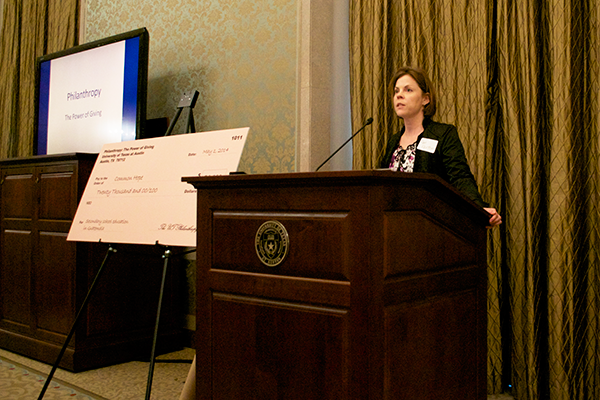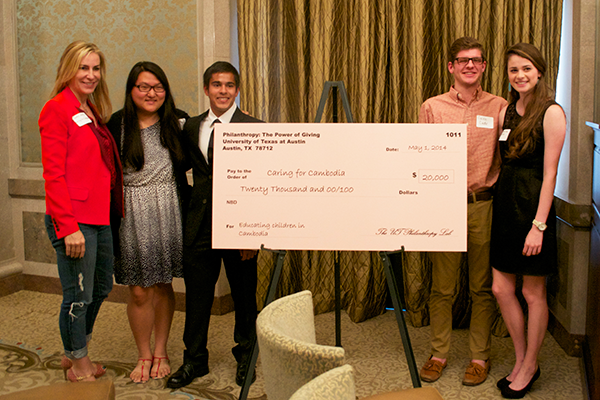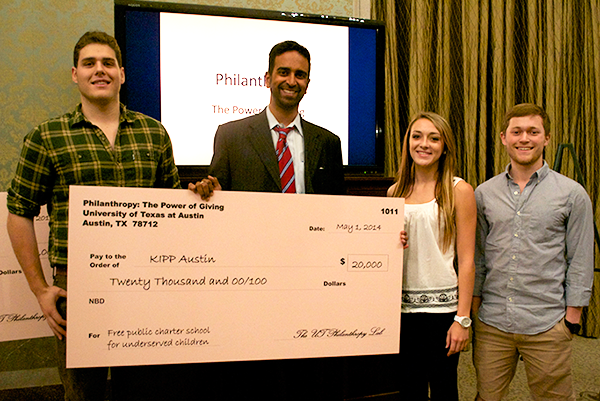Imagine walking into class on the first day knowing you will be responsible for giving away $100,000 at the end of the semester.
Forty students enrolled in the undergraduate studies course Philanthropy: The Power of Giving don’t have to imagine the feeling – they’ve done it.
The class, taught by sociology and government professor Pamela Paxton, is designed to teach students about the nonprofit sector and the importance of philanthropy to American society.
Paxton’s background as a social scientist has led her to incorporate social science techniques in the course that attempt to quantify charitable giving. That makes selecting the winning organizations at the end of the semester a little bit easier on students.

Synneve Williams, a freshman majoring in history, has always felt drawn to charitable and volunteer work, so the class seemed like the perfect fit to her.
“The essays we wrote and the presentations that we gave were great exercises in being concise and thinking on your feet, both crucial skills for college and later work life,” Williams says. “The coursework was unique in that it involved examining form 990 and other detailed financial information for these charities, which may be an unusual experience for most students.”
All the work students are assigned is linked back to the decision the class will make at the end of the semester, so the effort students put into it is unparalleled.
“The students take their assignments incredibly seriously, they’re extremely passionate about advocating,” Paxton says. “Their oral presentations may be the best prepared presentations they will ever do, because they’re trying to convince the class to pick their charity.”
At the beginning of the class, students were divided into 12 groups based on their philanthropic interests, anything from education to poverty to international organizations or the arts. Each group member then researched different charities and selected their favorite, giving a presentation to the class.
The groups then selected one charity to focus their efforts on and debated their selections with rival groups in front of the entire class to make sure everyone was as informed as possible about their options.
During the final week of class, students met to vote on which of the 12 remaining charities would receive their donations. The class could choose between 2 and 6 organizations from the finalists. They also determined the gift amounts through a vote. On May 1, they announced their selected charities and presented the groups with checks.
Though her charity wasn’t among the winning organizations, Williams was confident in the decisions the class made.
“The groups that lobbied for these charities did an excellent job on their presentations,” she says. “I feel that our money is being spent well.”
The organizations selected by the class are:
- Charity: Water – $30,000 to build two wells in Ethiopia.
- KIPP Austin – $20,000 to further free public charter schools for underserved children.
- Caring for Cambodia – $20,000 to build schools to further the education of children in Cambodia.
- Common Hope – $20,000 to further secondary school education in Guatemala.
- Sustainable Harvest – $10,000 to promote sustainable land use in Agua Fria, Honduras.
Students also had the opportunity to earn additional funds during the course, which helped them make smaller gifts to three other charities:
- $3,000 to Overseas Helping Hands
- $2,000 to Autism Trust
- $1,000 to Freedom from Hunger

Williams says that this course has given her a better understanding of the way the nonprofit sector operates and it’s made a career or internship with a charitable organization even more appealing to her. However, not all students participating in the class will end up working for a nonprofit organization.
Because it’s an undergraduate studies course, students of all majors and backgrounds enrolled in the class. They’re majoring in everything from history to computer science to business and engineering.
Paxton says that even if students don’t end up working for a nonprofit professionally, it could be that the next Bill Gates is in the class. It’s important for people to be thoughtful about charitable giving in the future, regardless of in what ways or by how much they can contribute.
Half of the course’s $100,000 gift was provided by a grant from the Once Upon a Time Foundation through their program, The Philanthropy Lab, which encourages universities to create undergraduate classes on charitable giving. The other $50,000 was raised through individual donations.
This is the third time Philanthropy: The Power of Giving has been taught on the UT campus, bringing the amount donated to charities selected by a class of undergraduate students at UT to more than $300,000.
A video about the last time the course was offered can be viewed here.
